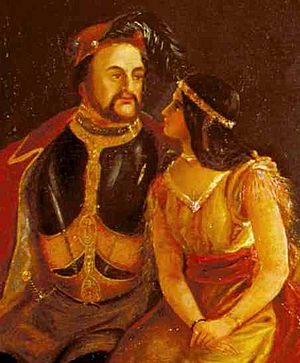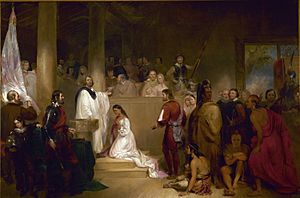John Rolfe facts for kids
Quick facts for kids
John Rolfe
|
|
|---|---|

A posthumous painting of John Rolfe and Pocahontas made c. 1850
|
|
| Born | c. 1585 Heacham, Norfolk
|
| Died | March 1622 (aged 36–37) |
| Occupation | Farmer, merchant, explorer |
| Known for | Being the husband of Pocahontas and the first settler in the colony of Virginia to successfully cultivate a tobacco crop for export |
| Spouse(s) |
Sarah Hacker
(m. 1608; died 1610)Jane Pierce
(m. 1619) |
| Children | Bermuda Rolfe (1609–1610) Thomas Rolfe (1615–1680) Elizabeth Rolfe (1620–1635) |
John Rolfe (born around 1585 – died March 1622) was an English explorer, farmer, and merchant. He is famous for two main reasons. First, he was the husband of Pocahontas, a Native American woman. Second, he was the first person in the Colony of Virginia to successfully grow a special kind of tobacco for sale. This tobacco became a very important crop for the colony.
Contents
Early Life and Big Ideas
John Rolfe was likely born in Heacham, Norfolk, England, around 1585. At that time, the Spanish Empire controlled almost all of the valuable tobacco trade. Spanish colonies in places like South America and the West Indies had climates perfect for growing tobacco.
English colonies, like Jamestown (founded in 1607), were not as good for tobacco. But people in England wanted more tobacco. This meant England had to buy a lot from Spain, which affected their trade balance. Rolfe saw a chance to change this. He wanted to grow tobacco in England's new colony in Virginia. He managed to get seeds from a popular tobacco plant grown in Trinidad, even though Spain had strict rules against selling these seeds to non-Spaniards.
Journey to Virginia
The Virginia Company of London started the Jamestown colony in 1607. This colony faced many problems. In 1609, a large group of new settlers and supplies was sent from England. This group was called the "Third Supply." John Rolfe and his first wife, Sarah Hacker, were on the lead ship, the Sea Venture.
The Third Supply fleet left England in May 1609. They sailed into a terrible hurricane in the North Atlantic. The ships got separated. The Sea Venture was leaking badly. To save everyone, the ship's admiral, Sir George Somers, purposely steered it onto the reefs of Bermuda. All 150 people and one dog survived!
They stayed in Bermuda for ten months. During this time, they built two smaller ships to finish their journey to Jamestown. Sadly, Rolfe's wife and their baby daughter, Bermuda Rolfe, died and were buried in Bermuda.
In May 1610, the two new ships sailed from Bermuda with 142 people, including Rolfe. When they reached Jamestown, they found the colony in terrible shape. Many settlers had died from hunger and sickness during a period called the Starving Time. Only 60 settlers were still alive. The arrival of Rolfe's group and another fleet led by Lord De La Warr saved Jamestown from being abandoned. After finally settling in, Rolfe began his important work with tobacco.
Growing Tobacco: A New Crop
The tobacco native to Virginia was not popular in England. Rolfe wanted to grow a sweeter kind. He used the special Spanish seeds he had brought from Trinidad. In 1611, he was the first to successfully grow Nicotiana tabacum tobacco plants for sale in North America.
This sweeter tobacco, which he called "Orinoco," began to be exported in 1612. It helped turn the Virginia Colony into a successful business. Rolfe named his tobacco "Orinoco" possibly after the Orinoco River in Guiana. This was a place Sir Walter Raleigh had explored while searching for the legendary city of gold, El Dorado. People liked Orinoco tobacco because of its nicotine and because it was fun to use in social gatherings.
In 1612, Rolfe started a large farm called Varina Farms. It was located along the James River, about 30 miles (48 km) upstream from Jamestown. The first four barrels of tobacco from his farm were sent to England in March 1614. Soon, Rolfe and others were exporting huge amounts of this new cash crop. Many new farms started growing tobacco along the James River.
Marriage to Pocahontas

John Rolfe married Pocahontas on April 5, 1614. Pocahontas was the daughter of Powhatan, a powerful Native American leader. Earlier that year, Pocahontas chose to become a Christian and was baptized. She took the name "Rebecca."
Powhatan gave the newlyweds land across the James River from Jamestown. However, they chose to live on Rolfe's farm, Varina Farms. Their son, Thomas Rolfe, was born in January 1615.
John Rolfe and Rebecca continued to grow tobacco successfully. In 1616, they traveled to England as guests of the Virginia Company. Their visit was meant to encourage more people to move to and invest in Virginia. Their young son Thomas, the deputy-governor Sir Thomas Dale, and 12 members of Rebecca's tribe, including her brother-in-law Uttamatomakkin, went with them.
They arrived in Plymouth, England, on June 12, 1616. They toured England, promoting the colony. Queen Anne and others were reportedly charmed by Rebecca. Investment in the Virginia Company grew. During their visit, John Rolfe wrote a report called "A True Relation of the state of Virginia Lefte by Sir Thomas Dale Knight in May Last 1616." This report was published in 1617 and further showed how well the Virginia colony was doing.
After nine months in England, the group prepared to return to Virginia. But bad weather delayed them. When they finally sailed in March 1617, they had to stop immediately in Gravesend. Rebecca was very sick. She died and was buried at St George's Church, Gravesend on March 21, 1617. Their son Thomas was also sick. It was decided he was too ill to survive the sea journey. John Rolfe had to return to Virginia without his son. He appointed Sir Lewis Stukley to care for Thomas until his uncle Henry Rolfe could take over. John Rolfe never saw his son again. Thomas recovered and stayed in England until he was an adult.
Later Life and Legacy
Rolfe returned to Virginia and continued his work with tobacco. In 1617, 20,000 pounds of Orinoco tobacco were sent to England. In 1618, another 40,000 pounds were sent. Around 1619, Rolfe married Jane Pierce. She was the daughter of Captain William Pierce, an English colonist who had survived the Sea Venture shipwreck with John in 1609. They had a daughter named Elizabeth in 1620. Elizabeth later married John Milner and died in 1635.
John Rolfe died in March 1622, just before a major Native American attack on the colony. His widow, Jane, later married Captain Roger Smith.
The land given by Powhatan to Rolfe (now called Smith's Fort Plantation) was left to Thomas Rolfe. Thomas, who grew up in England, returned to Virginia as an adult. He married Jane Poythress. Thomas and Jane Rolfe had one child, Jane Rolfe. She married Robert Bolling and had a son, John Bolling, in 1676. Jane Rolfe died soon after giving birth. John Bolling married Mary Kennon. They had six children who grew up and had their own families.
John Rolfe's Impact
- The special tobacco grown by Rolfe became the main crop that made the Virginia Colony successful. It was the most important crop for farms for many generations. Even today, tobacco is still a part of Virginia's economy.
- In eastern Virginia, State Route 31 is called the John Rolfe Highway.
- John Rolfe Drive in Smithfield, Virginia, is named after him.
- John Rolfe Middle School in Henrico County, Virginia, is named for him. The area of Varina in Henrico County is named after Rolfe's Varina Farms plantation.
- A road in western Henrico County is named the John Rolfe Parkway.
- John Rolfe has been shown in movies. He was voiced by Billy Zane in Disney's 1998 animated film Pocahontas II: Journey to a New World. Christian Bale played him in the 2005 film The New World.
Images for kids
See also
 In Spanish: John Rolfe para niños
In Spanish: John Rolfe para niños



